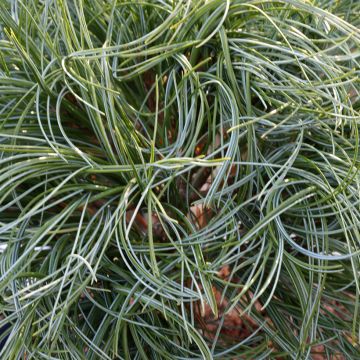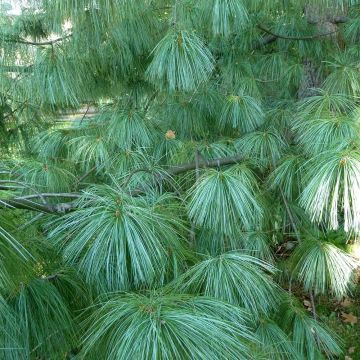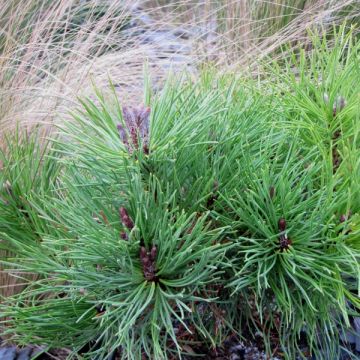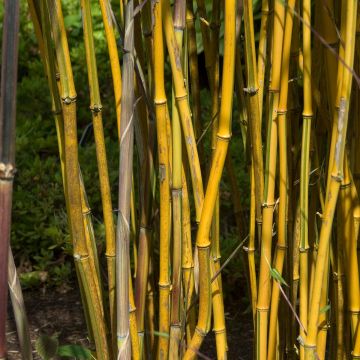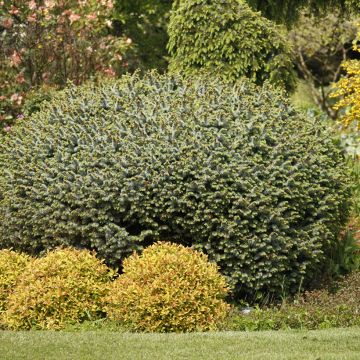

Pin blanc du Japon - Pinus paviflora Fukai
Pinus parviflora Fukai - Japanese White Pine
Pinus parviflora Fukai
Japanese White Pine, Five-needle Pine, East Asian White Pine
did not tolerate the wintering at 5°C (41°F) and once taken out in May did not start again, habit.
Marie-Thérèse, 15/09/2019
Special offer!
Receive a €20 voucher for any order over €90 (excluding delivery costs, credit notes, and plastic-free options)!
1- Add your favorite plants to your cart.
2- Once you have reached €90, confirm your order (you can even choose the delivery date!).
3- As soon as your order is shipped, you will receive an email containing your voucher code, valid for 3 months (90 days).
Your voucher is unique and can only be used once, for any order with a minimum value of €20, excluding delivery costs.
Can be combined with other current offers, non-divisible and non-refundable.
Why not try an alternative variety in stock?
View all →This plant carries a 24 months recovery warranty
More information
We guarantee the quality of our plants for a full growing cycle, and will replace at our expense any plant that fails to recover under normal climatic and planting conditions.

Would this plant suit my garden?
Set up your Plantfit profile →
Description
Pinus parviflora 'Fukai' is a dwarf form of the Japanese White Pine, with slow growth and a dense, compact habit that remains naturally uniform throughout its long life. Stunning in winter, it bears golden needles and in spring, gives way to highly coloured young shoots, blue-green with golden rings. These splendid colours are more pronounced when grown in full sun. Like all Japanese pines, it tolerates pruning well, allowing for the creation of a living sculpture over time. It is an ideal variety for large rockeries or to majestically structure a bed. Undemanding and very frugal, this small conifer prefers sunlight and well-drained soils.
Pinus parviflora, also known as the Japanese White Pine or Five-Needle Pine, is a plant from the Pinaceae family native to forests located at altitudes between 1300 and 1800m (4265 and 5905ft) in the Japanese islands. In its natural environment, this species can reach over 20m (66ft) in height and has a pyramidal habit, often as wide as it is tall, with a dense conical crown. Appreciated for its wood in Japan, this elegant species has given rise to very beautiful forms, often cultivated as bonsai.
Still relatively uncommon in Europe, the 'Fukai' variety, derived from this species, stands out for its small size and its very bright foliage in winter and spring. Its overall habit is rounded and bushy. Its dense growth is supported by a compact and branched framework, composed of foliage with changing and contrasting colours, very bright in winter and spring. Its growth is rather slow, around 11cm (4in) per year. At the age of 10, it will not exceed 1m (3ft) in all directions and will eventually form a large bush 2.40m (8ft) tall and 1.80m (6ft) wide. Its slightly twisted branches, covered with a dark brown bark, bear medium-sized needles that measure 4 to 6cm (2in) long. They are somewhat spiralled, grouped in fives and arranged in dense tufts, arranged in a helix. The bark of this small tree exfoliates in scaly plates over time.
The Japanese White Pine 'Fukai' will find its place in all gardens, from north to south (in not too hot an exposure), as its Japanese origins do not prevent it from thriving in very different climates. In small spaces, this remarkably coloured small tree will stand out when planted alone and will also bring a touch of brilliance to a large rockery or a sunny bed. It pairs well with large stones and the geometric lines of pools and masonry works. It can be associated with complementary grasses or sacred bamboos, in a very 'zen' spirit. The true graphic qualities of conifers naturally impose themselves in a contemporary garden, which prefers the use of shapes, silhouettes and textures over the dance of flowers. These plants, with their reassuring permanence, durably structure a bed, mark pathways, border terraces, easily replacing the strong presence of trimmed boxwood or holly. The key is to play with volumes and colours.
Report an error about the product description
Pinus parviflora Fukai - Japanese White Pine in pictures


Plant habit
Foliage
Botanical data
Pinus
parviflora
Fukai
Pinaceae
Japanese White Pine, Five-needle Pine, East Asian White Pine
Cultivar or hybrid
Other Pinus - Pine
View all →Planting and care
Pinus parviflora 'Fukai' is planted from September to November and from February to June in ordinary soil, even poor, even limestone, but well-drained. Choose a sunny spot or, at worst, partially shaded in hot climates, to avoid scorching the light foliage. Soak the root balls well before planting. Optionally, add organic amendment to the planting and water generously for the first two years, and in case of prolonged drought. In very poor soil, apply a special conifer fertilizer every year in April and cultivate the soil in summer. This very hardy conifer (up to at least -20°C (1°F)) is not afraid of wind, adapts to poor soils, but fears waterlogged soils in winter, scorching sun, and summer heatwaves. To keep it in even smaller dimensions, an annual pruning can be done from September to November by shortening the shoots that are considered unsightly, gradually shaping it to the desired form over the years.
Planting period
Intended location
Care
-
, onOrder confirmed
Reply from on Promesse de fleurs
Similar products
Haven't found what you were looking for?
Hardiness is the lowest winter temperature a plant can endure without suffering serious damage or even dying. However, hardiness is affected by location (a sheltered area, such as a patio), protection (winter cover) and soil type (hardiness is improved by well-drained soil).

Photo Sharing Terms & Conditions
In order to encourage gardeners to interact and share their experiences, Promesse de fleurs offers various media enabling content to be uploaded onto its Site - in particular via the ‘Photo sharing’ module.
The User agrees to refrain from:
- Posting any content that is illegal, prejudicial, insulting, racist, inciteful to hatred, revisionist, contrary to public decency, that infringes on privacy or on the privacy rights of third parties, in particular the publicity rights of persons and goods, intellectual property rights, or the right to privacy.
- Submitting content on behalf of a third party;
- Impersonate the identity of a third party and/or publish any personal information about a third party;
In general, the User undertakes to refrain from any unethical behaviour.
All Content (in particular text, comments, files, images, photos, videos, creative works, etc.), which may be subject to property or intellectual property rights, image or other private rights, shall remain the property of the User, subject to the limited rights granted by the terms of the licence granted by Promesse de fleurs as stated below. Users are at liberty to publish or not to publish such Content on the Site, notably via the ‘Photo Sharing’ facility, and accept that this Content shall be made public and freely accessible, notably on the Internet.
Users further acknowledge, undertake to have ,and guarantee that they hold all necessary rights and permissions to publish such material on the Site, in particular with regard to the legislation in force pertaining to any privacy, property, intellectual property, image, or contractual rights, or rights of any other nature. By publishing such Content on the Site, Users acknowledge accepting full liability as publishers of the Content within the meaning of the law, and grant Promesse de fleurs, free of charge, an inclusive, worldwide licence for the said Content for the entire duration of its publication, including all reproduction, representation, up/downloading, displaying, performing, transmission, and storage rights.
Users also grant permission for their name to be linked to the Content and accept that this link may not always be made available.
By engaging in posting material, Users consent to their Content becoming automatically accessible on the Internet, in particular on other sites and/or blogs and/or web pages of the Promesse de fleurs site, including in particular social pages and the Promesse de fleurs catalogue.
Users may secure the removal of entrusted content free of charge by issuing a simple request via our contact form.
The flowering period indicated on our website applies to countries and regions located in USDA zone 8 (France, the United Kingdom, Ireland, the Netherlands, etc.)
It will vary according to where you live:
- In zones 9 to 10 (Italy, Spain, Greece, etc.), flowering will occur about 2 to 4 weeks earlier.
- In zones 6 to 7 (Germany, Poland, Slovenia, and lower mountainous regions), flowering will be delayed by 2 to 3 weeks.
- In zone 5 (Central Europe, Scandinavia), blooming will be delayed by 3 to 5 weeks.
In temperate climates, pruning of spring-flowering shrubs (forsythia, spireas, etc.) should be done just after flowering.
Pruning of summer-flowering shrubs (Indian Lilac, Perovskia, etc.) can be done in winter or spring.
In cold regions as well as with frost-sensitive plants, avoid pruning too early when severe frosts may still occur.
The planting period indicated on our website applies to countries and regions located in USDA zone 8 (France, United Kingdom, Ireland, Netherlands).
It will vary according to where you live:
- In Mediterranean zones (Marseille, Madrid, Milan, etc.), autumn and winter are the best planting periods.
- In continental zones (Strasbourg, Munich, Vienna, etc.), delay planting by 2 to 3 weeks in spring and bring it forward by 2 to 4 weeks in autumn.
- In mountainous regions (the Alps, Pyrenees, Carpathians, etc.), it is best to plant in late spring (May-June) or late summer (August-September).
The harvesting period indicated on our website applies to countries and regions in USDA zone 8 (France, England, Ireland, the Netherlands).
In colder areas (Scandinavia, Poland, Austria...) fruit and vegetable harvests are likely to be delayed by 3-4 weeks.
In warmer areas (Italy, Spain, Greece, etc.), harvesting will probably take place earlier, depending on weather conditions.
The sowing periods indicated on our website apply to countries and regions within USDA Zone 8 (France, UK, Ireland, Netherlands).
In colder areas (Scandinavia, Poland, Austria...), delay any outdoor sowing by 3-4 weeks, or sow under glass.
In warmer climes (Italy, Spain, Greece, etc.), bring outdoor sowing forward by a few weeks.
































